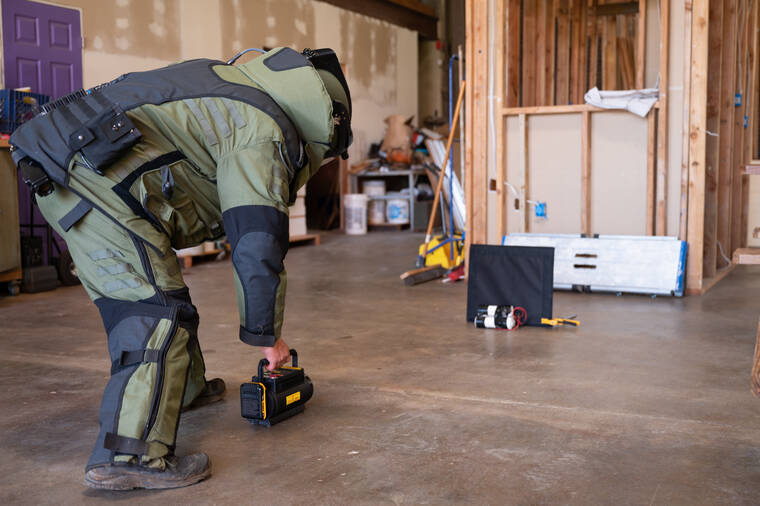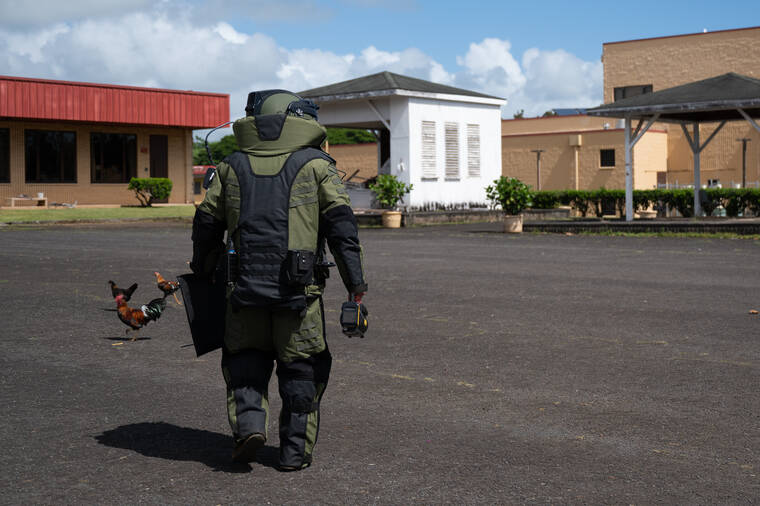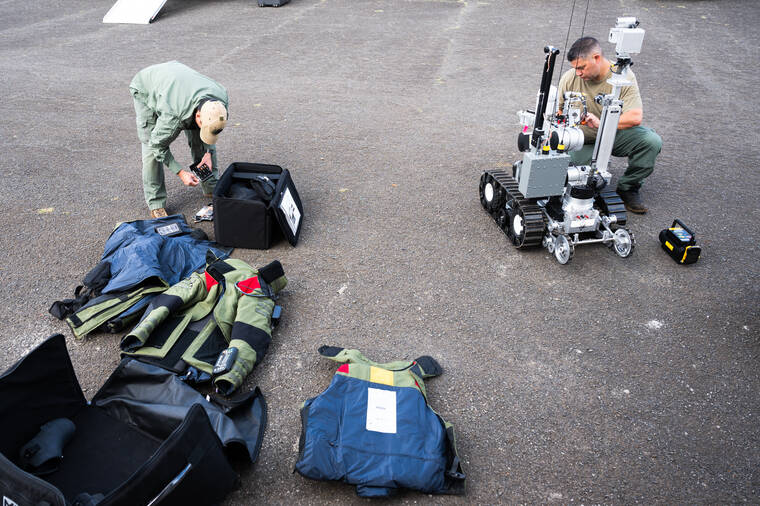PUHI — The next time something that could go “boom” needs to be dealt with on Kaua‘i, police won’t be stuck waiting for help to be flown in from Honolulu or the mainland.
That’s because two Kaua‘i Police Department detectives — Michael Nii and Hanson Hsu — completed a grueling, six-week, bomb-technician-certification course at Redstone Arsenal in Alabama last summer.
“It was one of the most challenging trainings that I have ever attended,” said Hsu. “It was both physically and intellectually challenging.”
The detectives now regularly train in bomb-disposal scenarios to keep their skills sharp.
In one such training at Kaua‘i Community College in Puhi last week, they demonstrated how the duo work as a team to safely find, assess and decommission explosive devices.
KPD asked The Garden Island not to disclose some information and practices in that process to prevent bad actors from taking advantage.
The team began the exercise by running through a fictionalized scenario in which a suspected explosive device had been found in a large workshop at KCC.
Their first steps were to ensure that the area had been safely evacuated and a perimeter was established to keep bystanders out of harm’s way.
“Our top priority is always to protect human life,” Nii said. “To handle and work with explosives is a big responsibility. The safety of the public, coworkers, yourself and the environment is the most-important thing.”
Their next step was to gather more information on the suspected explosive device. To accomplish that, they fired up the robot.
A sleek-looking silver contraption laden with cameras, sensors and an extending manipulator arm, the machine Hsu and Nii referred to rather simply as “the robot” is actually a Remotech Andros HD-SEL that was deployed down-range so that the detectives could assess the faux explosive from a safe location.
The robot, which KPD Assistant Chief Bryson Ponce said cost around a quarter-million dollars, can also carry a small X-ray imager, can climb stairs, and has an effective range measured in the hundreds of yards.
Moving on tracks, the robot maneuvered slowly but steadily through a parking lot, between vehicles, and into a large, bay-style workshop filled with lumber, boxes of nails and heavy construction tools.
The device — three lengths of capped white PVC tubing lashed together with electrical tape and strewn with wires — sat on the concrete just inside.
One of Hsu and Nii’s trainers, a civilian who asked to remain unnamed, said that the scenario that day was more straightforward than usual.
Often, he said, challenges are built into the situation to test the detectives and make them think outside the box. For example, the device could be hidden, placed in a difficult-to-reach area, or there could be multiple devices involved.
Even the relatively straightforward situation last week, though, presented its own challenges. And as impressive as the robot was, it couldn’t stand in for a steady pair of human hands. So, with the help of his partner, Nii donned the roughly 80-pound blast suit and went down-range himself.
Notably, the hulking green suit provides protection to nearly every part of a person — except their hands. The detectives said that it was a risk they had to take, leaving their hands exposed, because bomb disposal is too fine and intricate a process to do through gloves.
Nii methodically inspected the fake explosive, never turning his back to it, as Ponce looked on.
Ponce said that having bomb-disposal capabilities on-island was “another tool in the toolbox” for Kaua‘i, not only for the worst-case scenarios of successful or attempted bombings, but also for more-common incidents that involved explosive or incendiary devices like illicit fireworks, old military ordnance or phosphorous flares that wash up on the beach.
Nii detailed one case years ago in which police discovered a grenade while searching a house, and lacked the expertise necessary to safely handle it, forcing KPD to turn to a former military bomb technician who advised them on how to secure and transport the grenade.
“Like, what do you do?” Nii asked. “We just never had the capabilities to mitigate any type of explosive hazardous devices in the past.”
Ponce shared a story from April 2014 when KPD officers discovered a pipe bomb in Kalena Park in Lihu‘e. At the time, the only thing Kaua‘i’s police could do was set up a perimeter and wait for an explosive ordnance disposal team from the U.S. Army to be brought in from off-island. That process, he said, took days.
“KPD is the only show in town,” Ponce said, speaking on the challenges faced by police in an isolated environment like Kaua‘i. “You cannot be at the whim of an outside agency.”
As Ponce put it, Kaua‘i is a generally safe place to live, and having the capability at KPD to deal with hazardous explosives in a safe, timely manner is a proactive step in making sure that it stays safe.
•••
Kaleb Lay, general-assignment reporter, can be reached at 647-0329 or klay@thegardenisland.com.












Do they do this kind of training anywhere else in Hawai’i? This looks like an interesting job. Bomb squad technicians. An interesting curriculum they have there on Kaua’i. Do the candidates state their qualifications to enter into this program? Like when joining the police force. Or do they hire within. When the candidates become more on the job and then train for it. Bomb squad technician.
My nephew also did this training at the same facility in Alabama. He was chosen because he had many years (I believe it was at least 25 yrs) on the county police force in the state in which he lived and had been a member of the SWAT team for most of those years. One must be chosen to participate in the training and not many are selected. It is indeed very tough training.
Any training done to improve our Police force is wonderful!
Can they attend trainings on how to solve murders…?